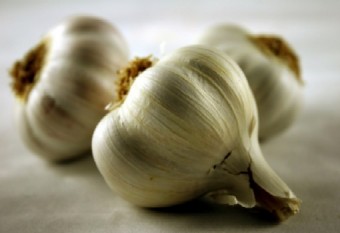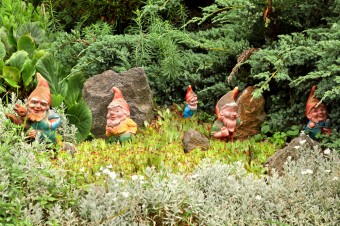Saturday, June 7, 2014

There are a few things going on to cause this bad smell, but principally the root cause is various sulfuric compounds from the garlic. Initially, most of the bad breath resulting from eating garlic comes directly from the sulfuric compounds introduced into your mouth. Not only that, but garlic actually promotes the growth of some of the microbes in your mouth that already cause bad breath, which further exacerbates the problem.
You may have noticed that even if you brush your teeth, rinse with mouthwash, and other such methods to clean out these compounds and various microbes from your mouth, the bad breath caused by garlic still remains to some extent. This has to do with the fact that some of these sulfuric compounds get metabolized, eventually making their way into your blood stream.
The primary smelly culprit here has been found to be allyl methyl sulfide, which is passed into the blood during the digestive process. Once it’s in your blood, it eventually gets passed out of your body through various bodily excretions, which includes being exuded through your pores and also passed into the air that fills your lungs. So as you breathe, the air goes into your lungs and is contaminated by the allyl methyl sulfide; this in turn causes your breath to continue to smell even if you’ve cleaned your mouth out.
As mentioned, this sulfuric compound will not only find its way into the air in your lungs, but also will be exuded from your pores. This ends up causing your whole body to smell, not just your breath. As you are excreting this sulfide, you essentially are wearing a stinky perfume. This effect lasts as long as it takes for your body to get rid of the stinky sulfuric compounds, which can be anywhere from a few hours to as much as a day after eating the garlic.
Because of the fact that the smelly sulfuric compounds from the garlic are in your blood, there is little you can do to immediately get rid of the smell from eating garlic, other than to mask it with a stronger smell. However, many people swear by parsley and sprigs for getting rid of garlic breath, which is why particularly parsley is often included in many dishes that contain significant amounts of garlic. Another popular cover up is to drink hot mint tea. Further, drinking milk while eating something garlicky has been shown to reduce bad breath and does an even better job if you drink the milk while the garlicky item is still in your mouth and swish it around.
Bonus Fact:
- The largest producer of garlic in the world is China, producing about 23 billion pounds of garlic annually, which is about 77% of the world’s supply of garlic.
Saturday, June 7, 2014 by Unknown · 0

The smell comes from the way certain chemical compounds in asparagus break down inside people’s bodies. This is why cooking asparagus in various ways does not result in the same smelly byproduct; the specific digestive enzymes that break down the compounds in the asparagus to produce the smell aren’t present until you eat the asparagus.
As to this specific resulting chemical compound that ends up causing the smell, it has long been thought that it is from methanethiol. Methanethiol is a colorless gas which smells a bit like rotting cabbage. It is composed primarily of sulfur, but also includes hydrogen and carbon.
More recent research by Robert H. White from the University of California proposes an alternative theory. White used gas chromatography-mass spectrometry to try to identify the cause of the smell and he concluded that it was actually from the s-methyl thioesters- specifically s-methyl thioacrylate and s-methyl thiopropionate. Thioesters, like methanethiol, are primarily sulfur based except are formed from sulfur bonding with an acyl group.
In either case, the ability of a particular person to produce the necessary smelly compound in their urine after digesting asparagus was thought to be a genetic trait unique to only some humans until relatively recently. Recent research done in France, China, and Israel, all independently showed this is not the case. Rather, all humans appear to produce the smelly compound, but only some humans can detect the smell; the ability to detect the smell or not is a genetic trait. Further, according to the study done in Israel, only about 22% of people have that genetic ability to smell the odor from the urine of people who have recently eaten asparagus.
Bonus Facts:
- The presence of methanethiol in the urine of someone who has recently eaten asparagus was first discovered by M. Nencki in 1891.
- The chemical compounds which cause the smell in urine from eating asparagus can appear as soon as fifteen minutes after a person eats asparagus.
- Asparagus belongs to the same family as lilies. Once the asparagus buds themselves start to open, the shoots themselves become unpalatable and woody, so typically only young asparagus shoots are used for eating, making all asparagus eaters baby killers.

- Methanethiol can commonly be found in the blood and brain of humans and various types of plant tissue. It can also be found in various types of nuts and cheeses.
- Methanethiol is also one of the major causes of bad breath.
- Tomatoes and Asparagus are good plants to grow near one another due to the fact that tomatoes keep the asparagus beetle away and asparagus repels certain types of root nematodes that are bad for tomatoes.
- Asparagus is an extremely healthy little plant. It contains quite a bit of calcium, zinc, magnesium, fiber, thiamin, riboflavin, rutin, niacin, folic acid, iron, phosphorus, potassium, copper, manganese, chromium, and selenium. It also contains good amounts of vitamin A, B6, C, E, and K.
Quotable Asparagus Quote:
- “A few stems of asparagus eaten shall give our urine a disagreeable odor; and a pill of turpentine no bigger than a pea shall bestow upon it the pleasing smell of violets.” -Ben Franklin
by Unknown · 0

Those millions of bacteria have to live somewhere.
Sweat and Odor
There are two universally-accepted types of sweat glands.
Eccrine Glands
The most abundant of the sweat glands, eccrine are found on most of the body andsecrete a sweat that is: “A sterile, dilute electrolyte solution that contains primarily sodium chloride (NaCl), potassium and bicarbonate . . . .”
Most of us are familiar with the reason our eccrine glands produce sweat: “Continuous secretion . . . provides a mechanism for thermoregulation via evaporative heat loss [and] maintenance of electrolyte balance . . . .”
Apocrine Glands
This type of gland is found in hairy places on the body, such as the armpits and between the legs. Near the skin’s surface, inside the hair follicle, apocrine glands secrete: “A milky fluid that most commonly [occurs] when you’re under emotional stress. This fluid is odorless . . . .”
Despite its innate lack of smell: “[Apocrine sweat] is rich in precursors of odoriferous substances (cholesterol, triglycerides, fatty acids, cholesterol esters, squalene). It also contains androgens, carbohydrates, ammonia and ferric iron.”
In addition, this gland produces pheromones, the “chemical signals that instigate behavioral responses (e.g. sexual attraction).”
Armpit Funk
At any given moment, there are 100,000,000,000,000 (one hundred trillion) bacteria living on your body. So, of course, a few are going to wander down to the smorgasbord that is your armpit, itself “home to one million bacteria per square centimeter.”
Dining on the aforementioned precursors, notable axillary stinkers include Corynebacterium spp., Staphylococcus spp., Micrococcus spp. and Propionbacterium spp., and, depending on their food of choice, any of a range of offensive odors can be produced: “The sulfur-containing molecules are the worst, giving armpits their characteristic nauseating, onion-like smell. . . [while others produce] a cumin spice-like odor . . . . Two possible pheromones, androstenol, which is musky, and androstenone . . . [may also contribute. Finally,] isovaleric acid has a cheesy, sweaty foot smell, as does propionic acid.”
A Wealth of Information
Researchers have determined that some mammals are born with distinct bouquets, organized into odortypes: “An individual’s odortype is determined in part by genes in [the] . . . major histocompatibility complex (MHC), which plays a role in the immune system . . . .”
Acting as “olfactory nametags,” an individual’s unique fragrance helps others identify him, and apparently, it cannot be changed, no matter how much garlic and cumin he eats: “In behavioral tests, ‘sensor’ mice were trained to use their sense of smell to choose between pairs of test mice that differed in MHC genes, diet or both. . . . The results . . . indicate that genetically determined odortypes persisted regardless of what the mice ate, even though dietary changes did strongly influence the odor profiles of individual mice. Both the sensor mice and chemical analysis could still detect the underlying odortypes.”
The study’s authors concluded that: “If this can be shown to be the case for humans, it opens the possibility that devices can be developed to detect individual odorprints in humans.”
Later research explored the extent to which disease in a body gives off an aroma by taking advantage of the olfactory virtuosity of our canine friends: “A Belgian Malinois shepherd was trained . . . to scent and recognize urine of people having PCa [prostate cancer] . . . After a learning phase and a training period of 24 mo, the dog’s ability to discriminate PCa and control urine was tested in a double-blind procedure. . . . . The dog . . . correctly designated the cancer samples in 30 of 33 cases. Of the three cases wrongly classified as cancer, one patient was rebiopsied and a PCa was diagnosed.”
It Could Be Worse
Some people suffer from a condition where they’re body odor smells like rotting fish. Calledtrimethylaminuria, people with this disorder cannot break down trimethylamine: “Which is found in eggs, liver, legumes and some grains. [Commonly] it is broken down by bacteria [and] . . . is normally oxidized in the liver to odourless TMAO [trimethylamine], which is excreted from the body.”
The compound smells like fish because it is commonly found in them. It is “believed… it… increases osmotic concentration and thus depress the freezing point of body fluids.”
In people who suffer from trimethylaminuria, the smell is emitted in their “sweat, urine and breath,” a condition often leading to social isolation and derision, such as the much-reviled Caliban of Shakespeare’sThe Tempest: “What have we here? a man or a fish? dead or alive? A fish: he smells like a fish; a very ancient and fish-like smell . . . . A strange fish!”
Trimethylaminuria is a rare inherited condition that only occurs in people who inherited two copies of the defective gene, one each from their mother and father. It is estimated that 1 in 10,000 suffers from this syndrome.
by Unknown · 0

Garden gnomes are those statues you see of pint sized chubby human-like creatures usually wearing red hats and blue pants. You can find them in a variety of poses and pursuing various past times such as fishing, napping, or in the case of my personal gnome, smoking a pipe. Garden gnomes are typically male and have beards but you see the occasional female gnome statue these days.
While it took longer to catch on in the United States, garden statuary has been popular in European countries since at least the Renaissance. Saints, gods and mythical creatures were among the early figures depicted, and one character called Gobbi, which is Italian for “dwarf” or “hunchback”, starting in the early 1600s.
From there, references of “House Dwarves” are found in the late 1700s. These statues were made of porcelain and produced continuously through the 19th Century. It is believed the dwarves morphed into gnomes and moved from the house to the garden when Baehr and Maresch out of Dresden, Germany started producing their own take on the dwarves around 1841.
Sir Charles Isham was also a key figure in the spreading of the gnome, when he introduced gnomes to the United Kingdom by bringing 21 of the terracotta figures home with him from a trip to Germany around 1847 and placed them in the garden of his home. (Amazingly, one of those original gnomes is still around. Lampy, as the statue is called, is on display at Isham’s home, Lamport Hall.)
Within a couple decades of Sir Isham’s trip, garden gnomes began being strongly associated with Gräfenroda, Germany, a region famous for its ceramics. The two biggest players in the industry there were August Heissner and Philip Griebel (with the Griebel company still producing the gnomes to this day).
Griebel originally specialized in decorative terracotta animals but branched out to produce gnomes based on existing local myths about the creatures. These legendary magic using gnomes were said to be earth elementals (hence their placement in gardens) who lived underground in the daylight where they guarded their treasures, and would emerge at night. If they were caught out in daylight, they’d turn to stone, which of course lends itself to the idea of the garden gnome statues.
Thanks largely to Heissner and Griebel’s designs, the garden gnome’s popularity quickly spread across Germany and Europe and then the world.
Besides just sticking the Gnomes in a garden, another modern Gnome “tradition” has recently popped up- Gnome-napping. Essentially, you steal someone’s garden gnome, then take it on a trip or other sort of adventure while taking lots of pictures of what the gnome’s been up to on its journey and send them back to the owner. If you choose, when you’re done, you return the gnome to where it started. This practice seems to have started in the 1980s in Australia, but saw a huge upswing in popularity thanks to the 5 time Academy Award nominated 2001 film Amelie where this is depicted.
Bonus Fact:
- Popular or not, garden gnomes and their owners have faced persecution through the years. In 2006, the Royal Horticulture Society of Britain banned the use of “brightly colored creatures” in landscaping for the Chelsea Flower Show, considered to be the gardening world’s equivalent to the Kentucky Derby. Unfortunately, the ban applied to gnomes. Show organizers claim the decorations detract from garden designs, but gnome supporters say it’s a case of snobbery because the gnomes are popular and common in the gardens of working class people.
by Unknown · 0

Ponies and horses are both equines. In general, a horse is an equine that stands about 14.2 hands high or more and a pony is an equine that stands under that mark, give or take depending on region; for instance, in Australia the dividing line is 14 hands rather than 14.2.
That being said, although the main distinction between the two is size, size is not the only determining factor. There are some horses smaller than a typical pony size that are not ponies but horses. For instance, breeds such as the Falabella horse, which stand no taller than 7.5 hands, are considered very small horses, not ponies. Further, Caspian horses almost always are under 12 hands, yet aren’t considered ponies.
What? Why? In a word, phenotypes. In more words, the answer lies in their temperament and physical makeup. Ponies are typically much stockier than their horse relatives. They also have thicker manes, tails, and coats, so are better able to endure cold weather. They have proportionally shorter legs, wider barrels (body of the pony that encloses the ribcage and all major internal organs), heavier bones, shorter and thicker necks, and short heads with broader foreheads. They also typically have calmer temperaments and a high level of equine intelligence which can be used to a human handler’s advantage. Children love getting pony rides don’t they?
So that’s it. Horses and ponies are both equines. Size typically determines whether or not they are considered a horse or a pony, but their temperament and other aspects of their physical make-up also count.
Now, you might at this point be wondering what exactly a “hand” is and how horses and ponies are measured. The height of ponies and horses is measured from the highest point of the withers, which for you non-equestrian connoisseurs is the point where the neck meets the back. The withers is used for measurement since it is a stable part of the anatomy, unlike the head and neck which move up and down with the body of the horse. Their height is measured in hands and inches with one hand equivalent to 4 inches. When written, a pony or horse’s height is written in the number of hands, followed by a decimal and then the number of inches. For instance, if a horse is 61 inches tall, its height would be written as 15.3 h for 15 hands and 3 inches.
Bonus Horse and Pony Facts:
- The modern domestic horse can live about 25-30 years. Some have lived to be 40 years old and some even older but that is very uncommon.
- For your reference, a foal is a horse of either sex less than one year old. Foals who are nursing are called sucklings and those who have been weaned are called weanlings. A yearling is a horse of either sex that is between one and two years of age. A colt is a male horse under four and a filly is a female horse under the age of four. A stallion is a non-castrated male who is four years or older. A gelding is a castrated male of any age. A mare is a female horse four years or older.
- The oldest verifiable record of the longest living horse was that of “Old Billy”, a 19th century horse who lived to the age of 62. According to the Guiness Book of World Records the record for the “world’s oldest living pony” died in 2007 at age 56.
- The largest horse in recorded history was a a Shire Horse called Mammoth. He was born in 1848 and stood 21.2 hands high (86.5 inches) and weighed 3,300 pounds!
- The world’s smallest horse is named Thumbelina. She is a fully mature miniature horse, however she suffers from dwarfism. She is 17 inches tall and weighs only 57 pounds.
- The world’s smallest pony was named “Little Pumpkin.” He stood 14 inches and weighed only 20 lbs!
- A horse’s teeth take up more space in their head than their brain.
by Unknown · 0

On November 30, 2012, the Korean Central News Agency, North Korea’s government “news” agency, reported that scientists had “reconfirmed” the existence and location of the final resting place of the unicorn ridden by King Dongmyeong, the founding father of Goguryeo of an ancient Korean kingdom. The unicorn’s grave was located under a rock near the North Korea capital of Pyongyang with an engraving that read “Unicorn’s Lair.”
Like many supposed news reports that comes out of North Korea these days, this reported evidence that a mythical creature like the unicorn once existed was mostly ignored and laughed at by the world’s science community. After all, this was the same news agency that reported former leader Kim Jong Il invented the hamburger and had eleven hole-in-ones the first time he ever hit the links. (What, he wasn’t good enough to get 18 hole-in-ones?) So, it’s fair for this outrageous claim to be taken as such. But unicorns have been discussed and given mythical status for centuries now, in religious texts, travel observations, and even ancient academic papers. Did unicorns, at one point, actually exist? If they didn’t, then where did the legend of this magical horse with one horn come from?
For the uninitiated, unicorns are mythical creatures that possess a single horn protruding from it’s forehead. Legends vary on exactly what powers the unicorn held. Some say it could fly, others said their horns possessed incredible healing power, and still others said that unicorns were immortal.
The first known depiction of a one-horned “unicorn” is commonly said to be found in the ancient Lascaux Caves in France. The drawings date back to 15,000 BCE. In actuality, the creature on the cave walls had two horns, but the original discovers got confused due to the close approximation of the horns in the drawing. More likely, the drawing depicts some sort of bull or antelope.
The first written account of a unicorn in Western literature comes from the Greek doctor Ctesias in the 4th century BCE. While traveling through Persia (modern-day Iran), he heard tales of a single-horned “wild ass” roaming the eastern part of the world from fellow travelers. In his writings (obtained from Odell Shepard’s 1930 research manuel “Lore of the Unicorn”), Ctesias described these creatures as “large as horses” with white bodies, red heads, and blue eyes. Ctesias depicted the horn as multi-colored and about a foot and half in length.
They were so swift and powerful, claimed Ctesias, that “no creature, neither the horse or any other, could overtake it.” According to Time Magazine’s article “A Brief History of Unicorns,” it was likely Ctesias never saw this creature himself, but rather combined the portrayals told to him by his foreign friends. Other well-known figures throughout history reported their own unicorn sightings, including Marco Polo (calling them “ugly brutes”), Genghis Khan (who supposedly decided to not invade India upon seeing the creature), and Pliny the Elder.
According to many scientists, what these people saw (or, in Ctesias’s case, what was described to him) may actually have been a rhinoceros. The Indian rhinoceros fits many of the descriptions recorded when those encountered a unicorn – the one horn, the powerful nature, and even Polo calling them “ugly brutes.” While rhinos and horses do not look much alike, horses were a well-known quantity back home. People knew what were horses were. It was quite believable and gives a vague image of what the animal looked like, similar to how Koala’s got the “bear” tacked onto their name and were also at one point called “monkey bears”. In fact, this theory is so widely-held, the scientific name of the Indian rhino is rhinoceros unicornis.
The unicorn is even mentioned in the King James version of the Bible nine times. “God brought them out of Egypt; he hath as it were the strength of an unicorn” and “Save me from the lion’s mouth; for thou hast heard me from the horns of unicorns” are just two of the unicorn-themed lines in this version of the Bible.
This may be a case of simple mistranslation. In the Hebrew Bible (the Torah), there are references to a creature known as “re’em.” Scholars believe “re’em” were a now-extinct type of wild ox or, potentially, the now endangered but still existing, Arabian oryx. At no point does the Torah make any reference to this animal being one horned, though there is Mestompian art that depicts these animals’ profiles in which only one horn is visible. When the Old Testament was translated to Greek, these creatures took on the word “monokeros” meaning one-horned, due to the writers being familiar with the artwork than the actual transcripts. In the Latin Bible, this became “unicornos” and then, into the English translation, “unicorn.” Like a crazy game of telephone, a wild ox or Arabian oryx became a mythical one-horned flying horse.
Unicorn believers also use the existence of the narwhal as further proof that their beloved creature once roamed the Earth. The narwhal is a member of the whale and porpoise family and owns a single horn – actually, it’s a tooth – located in the middle of it’s forehead. The tooth is used during mating and to create holes in the ice of the cold waters of the Canadian Arctic and Greenland they often live in. These unicorn supporters speculate that unicorns, being threaten on land by hunters and those wishing to do them harm, took the the sea and evolved into the narwhal. However, narwhals, in fact, are actually much closer to beluga whales, dolphins, and porpoises than horses in terms of DNA.
All of this evidence seems to point to that unicorns, at least in the form we traditionally think of, never actually existing. More likely, Indian rhinos, now-extinct wild ox, and Arabian oryx were combined to form the myth of the unicorn. Though, if you still think the unicorn is real, there is a place for you: Lake Superior State University in Sault Ste. Marie, Michigan. In 1971, the college created “the Unicorn Hunters,” a group dedicated to the staking out and hunting of these mythical creatures. Though the group disbanded in 1987, you can still apply for a Unicorn Questing license on the university’s website.
Bonus Facts:
- Comparable to ivory, unicorn horns were an extremely valuable commodity (which, of course, didn’t really exist) and people would “hunt” unicorns simply to reap the profits of its horn. At its highest value, a unicorn horn was worth roughly ten times its weight in gold. In the 16th century, a unicorn horn was sold to the Pope for 90,000 scudi – roughly equivalent to 18,000 pounds. Pharmacies in London sold powdered “unicorn horn” as late as 1741.
- Beginning in the 15th century, there was a widely held belief that the most effective way to hunt unicorns was by using a virgin as bait. Art started showing images of unicorns resting their one-horned heads in the laps of virtuous women. One example of this is the tapestry known as “Maiden with Unicorn” which hangs in the Musée de Cluny (the National Museum of the Middle Ages) in Paris, France. The sexual overtones of this piece, and of many others like it, are not particularly subtle.
- Other countries also developed their own unicorn-esque legends, like the Japanese kirin, a fierce creature who was known to kill off bad guys by piercing them through the heart with its horn. In China, the qilin, or to westerners the “Chinese unicorn,” is, despite it’s intimidating demeanor, peaceful and when it appeared, it meant good was about to happen. In fact, whenever a respected ruler passed or was slated to be born, a qilin would appear to alert the people that greatness was among them…
by Unknown · 0

Lupus, Latin for “wolf”, is a chronic (long term) autoimmune disease. Meaning the body’s immune system mistakenly attacks healthy tissue instead of harmful bacteria, viruses, or other harmful organisms.
Tracing back to the 14th century, lupus and cancer were both common names for an ulcerous disease. Cancer could involve any tissue, but lupus specifically refereed to afflictions of the skin. In the 16th century, Paracelsus compared the ulcers to a hungry wolf eating flesh because he thought the lesions were taking up excessive blood supply, leaving less for surrounding tissue.
Currently there are several different types of lupus. The symptoms for each can vary greatly. Lupus causes long term inflammation and the results can cause a wide range of symptoms. There is no known specific cause of lupus, but it’s thought to be the result of a combination between genetic and environmental factors.
The body has a natural defense against bacteria viruses, and other harmful foreign organisms, in the form of our immune system. Normally an organ known as the thymus produces certain types of cells (T cells) that recognize our own healthy cells. They do this by recognizing what is known as MHC molecules. When these T cells become restricted, the body’s immune system can become unable to distinguish our own healthy cells from harmful foreign cells. The result can be an autoimmune disease like lupus.
There are over 80 known types of autoimmune diseases, some common ones include: Multiple Sclerosis, Graves disease, Rheumatoid arthritis, type 1 diabetes, Celiac disease, and more recently known, Narcolepsy.
We all know the common symptoms of an immune response. Who hasn’t had a cold or flu and not felt the reaction from the body fighting the problem? Things like inflammation, fever, weakness, fatigue, and painful joints are common. Many autoimmune diseases will first begin to present in the same way. The damage to healthy tissue, as a result of this autoimmune response, will vary depending on the severity of the response. The symptoms can be as severe as the damage.
In the case of lupus, these symptoms can specifically be things like extreme fatigue, anemia, swelling in the feet, hands or around the eyes, chest pain when breathing deeply, hair loss, sun or light sensitivity, abnormal blood clotting, and a butterfly-shaped rash across the cheeks and nose.
There are several different types of lupus, including Systemic lupus erythematosus (SLE), Discoid lupus erythematosus, Drug induced lupus, neonatal lupus and Subacute cutaneous lupus erythematosus. (see “types of lupus” below for an explanation of each)
The type most people think of when talking about lupus is SLE. This type is systemic, affecting several different parts of the body. The symptoms can range from mild to serious and can even lead to death. It affects approximately 1.5 million Americans, and about 16,000 new cases are diagnosed each year. Unfortunately ladies, 90% of the cases are women between the ages of 15 and 45.
Lupus’ symptoms can begin like those of any natural immune response, due to this and because it can affect so many different body systems, there is no single test that can be used to diagnose it. One common method is to test for antibodies known as antinuclear. It is known that people with higher than normal levels of these antibodies have a 50% chance of having an autoimmune disease, and 95% of people with SLE have these antibodies present. Unfortunately, these types of antibodies can also be present in people who don’t have an autoimmune disease. Your doctor will have to use these results in combination with your signs and symptoms to accurately diagnose you.
Some common signs they might look for while paring symptoms with lab tests include Pleuritis, which is inflammation of the lining around the chest cavity that can cause pain when breathing; inflammatory conditions of the lung, commonly known as pneumonia; non-painful kidney problems that result in things like dark urine, swelling of legs, ankles or fingers known as edema; central nervous system problems that cause headaches, dizziness, vision problems, seizures, memory disturbances, and stroke; heart problems like inflammation of the heart itself, known as myocarditis or endocarditis; and inflammation of the lining of the heart known as pericarditis.
Like so many other autoimmune diseases, there is no known cure for lupus. The treatment revolves around symptom control- minimizing inflammation, reducing pain, and stopping the development of serious organ damage.
As you would expect, drugs to treat inflammation like aspirin, ibuprofen, and other non-steroidal anti-inflammatory drugs (NSAIDs) are commonplace. For more serious inflammatory responses, Corticosteroids can be used. Immunosuppressive medication and antimalarial drugs are often used. In some cases, anticoagulants (anti-clotting) drugs are prescribed.
You can see that because lupus will present in so many different ways and the symptoms mimic many different types of problems, it can take several years to appropriately and accurately diagnose someone with it. In fact, there are 11 criteria involved with lupus- 7 are related to your symptoms and 4 have to do with lab tests. You will need to have 4 of the 11 criteria before you doctor will consider diagnosing you with the disease.
So don’t get frustrated with your doctor if it takes a while. The postulate, “if it looks like a duck and quacks like a duck, it must be a duck”, does not apply. In this case, all of the problems are ducks and they all kinda look the same. Duck hunting anyone!
Types of lupus:
- Systemic lupus erythematosus- The most commonly talked about type, it can affect several different body systems at the same time. Central and peripheral nervous systems, digestive tract, heart, lungs, and skin. The presentation really revolves around which systems are affected and how severely they are influenced.
- Discoid lupus erythematosus- This type only involves the skin and presents with a red, raised rash- usually on the face and scalp, the raised area can become scaly and thick. The rash can last for days, weeks, or even years. If you have Discoid lupus there is a small chance you could develop SLE.
- Subacute cutaneous lupes erythematosus- This type of lupus is also skin related, and refers to skin lesions that appear on body parts exposed to the sun. They don’t tend to cause scaring.
- Drug-induced lupus- As the name implies, this type of lupus is caused by certain types of medications, including anti-seizure, high blood pressure, antifungals, antibiotics, thyroid medications, and oral contraceptives. They all can cause similar symptoms as SLE. The main difference is that the symptoms go away when you stop the medication.
- Neonatal lupus- This is a rare type of lupus that occurs in the newborn babies of women with SLE. At birth, the babies can have a rash, liver problems or low blood counts. The symptoms will usually go away over the course of months, however the babies can have serious long term complications- things like congenital heart blocks caused by fibrous tissue interfering with electrical impulses in the baby’s heart. Ladies with SLE, not to worry, most infants of mothers with SLE are born absolutely healthy.
by Unknown · 0
Subscribe to:
Comments (Atom)